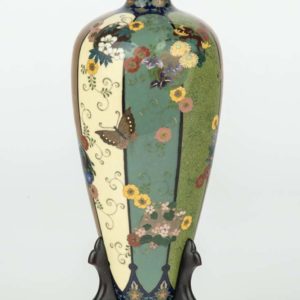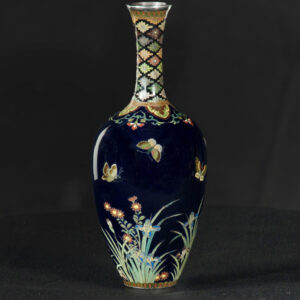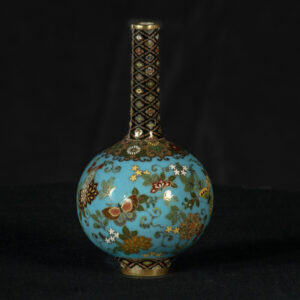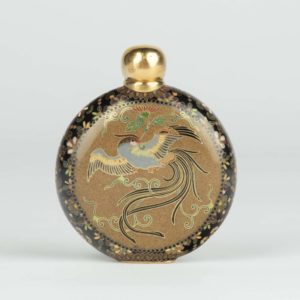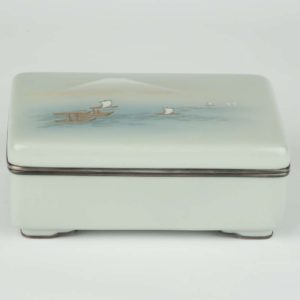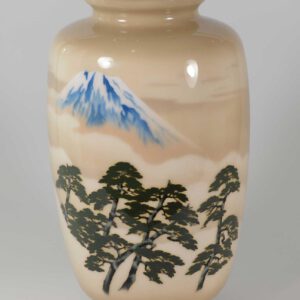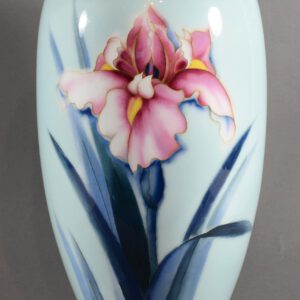Japanese Enamels
It would be difficult to argue the facts that Japanese cloisonné of the late 19th and early 20th centuries was certainly the last, if not the greatest of the Japanese...

It would be difficult to argue the facts that Japanese cloisonné of the late 19th and early 20th centuries was certainly the last, if not the greatest of the Japanese arts. Originating in Europe sometime in the 11th century B.C, cloisonné had undergone numerous transitions and name changes, prior to arriving in Japan in the 17th century as a decorative but poorer quality representation of finer Chinese works.
It was not until 1838 that an artist known as Kaji Tsunekichi literally re-invented the art of making cloisonné , and produced the first free standing items ,such were his skills that soon the Japanese were copying Ming period Chinese wares to an incredible standard , many of which had and would continue to fool experts in the oriental market , but it wasn’t until almost 30 years later that better known artists like Hayashi Kodenji the first (one of four) started to produce wares for export , firstly out of the port of Yokohama , there was a sudden explosion of interest in this new found product and it was shown at the worlds first exposition in Paris in 1867, the first cloisonné factory opened in Nagoya in 1870 followed by factories in Kyoto and Yokohama ,some of the better products went on to win medals at the many worldwide expositions , the government quickly embraced the opportunities these wares could produce for the economy and its standing in the world markets , the village of Toshima literally turned into a micro City overnight , it had numerous artisans working in tiny workshops and newly built factories, so much so it became known as cloisonné City ,with around 125 kilns and literally hundreds of workers feeding the wests insatiable appetite for Japanese enamel wares.
It was in 1871 that a certain Namikawa Yasayuki left his position as Samurai to begin to learn and perfect cloisonné production , without doubt Yasayuki went on to become the absolute master cloisonné maker , his works have rightly been recognised as such, with surviving examples becoming the cloisonné connoisseur’s most wanted pieces of Japanese enamel , rarely were his items produced in a large scale(usually under 30 cm) and never in the mass produced manner of other artisans working in that period , he developed new coloured enamels including black and translucent, and firing techniques that completely transformed Japanese cloisonne enamel , the previous early and middle period, muddy looking and often Chinese influenced wares were now redundant , along with Yasayuki’s new enamels came his drawings , designs and decoration, now with an eye for the Japanese taste , finished with highly polished enamels that had never been seen before , Yasayuki worked in a small workshop in Kyoto employing about a dozen or so artisans, he apparently oversaw everything that left his workshop , including giving each piece its final polish before placing it in its Tomobako for its onward journey to the lucky recipient , often the imperial household , it was noted that a worker could sit with a bowl of his favourite pebbles and painstakingly polish one single piece for many months , it is therefore not difficult to understand why a perfect piece of Namikawa’s cloisonné work is so highly desirable over a century later.
Another huge step forward in what was fast becoming the “Golden age” of Japanese cloisonné was the ability to produce Musen or Wireless cloisonne , this was first invented in 1889 by an artist working in Tokyo called Namikawa Sosuke (no relation to Yasayuki), Sosuke had dreamed of painting tranquil scenes using enamel but without wires ,he eventually came up with a technique of removing the wires ( cloisons) after decorating but before final firing , this resulted in him fulfilling his dream of producing exquisite shaped plaques or trays, usually decorated with native birds and flora or landscape scenes of lake Biwa or Mount Fuji, once again these are very highly desirable to the worlds many cloisonné collectors.
During this Golden Era the two most famous and long standing factories were founded , firstly the Ando factory of Nagoya founded by Ando Jubei in around 1881 followed by the Inaba Company of Kyoto in 1887 ,the opening of the Inaba factory sadly coincided with the closure of the Nagoya cloisonné company.
Many other techniques were re- invented and perfected by the numerous household names that we know of today, including importantly the Moriage technique, introduced by Kawade Shibataro in conjunction with Ando Jubei , this involved the stacking of enamels to form a raised kind of “in relief” finish , and Plique –a-Jour (a glass like translucent finish first used in France in the 15thc) another technique practised and further perfected by the two previously mentioned artists.
In summary the number of cloisonne artists and factories are too numerous to fully list ,with many still unknown in what transpired to be a magical period, ”The Golden age “ defined as the thirty years (1880-1910) in which artists of varying skill levels, transformed a product that had been made for around three thousand years into one of the finest arts Japan has ever produced.
As with most works of art ,cloisonné is available in different qualities and at varied price levels ,some of the cheaper and higher production pieces in the lower hundreds of £ budget would rarely be signed but should be enjoyed as quality decorative objects in their own right, together with the mid- range pieces in the higher hundreds to lower thousands bracket, once again mostly unsigned but should continue to give much pleasure and yield sound returns if purchased from reliable sources at the outset, in our opinion perfect pieces of Japanese cloisonné are still grossly undervalued, when you consider the dozens of man hours each piece took to manufacture, our aim is to supply you with such pieces on a regular basis.
Meanwhile the search continues for the very best signed pieces by either of the two Namikawa’s , Ando Jubei , Kumeno Teitero , and the other masters of enamel ware.
It is therefore probably very apt that the Japanese name for cloisonné is “Shippo “ Which literally means “Seven treasures “ and no better words could be used to describe pieces made during that Golden Age.
Showing all 7 results
Filter Your Results
It would be difficult to argue the facts that Japanese cloisonné of the late 19th and early 20th centuries was certainly the last, if not the greatest of the Japanese arts. Originating in Europe sometime in the 11th century B.C, cloisonné had undergone numerous transitions and name changes, prior to arriving in Japan in the 17th century as a decorative but poorer quality representation of finer Chinese works.
It was not until 1838 that an artist known as Kaji Tsunekichi literally re-invented the art of making cloisonné , and produced the first free standing items ,such were his skills that soon the Japanese were copying Ming period Chinese wares to an incredible standard , many of which had and would continue to fool experts in the oriental market , but it wasn’t until almost 30 years later that better known artists like Hayashi Kodenji the first (one of four) started to produce wares for export , firstly out of the port of Yokohama , there was a sudden explosion of interest in this new found product and it was shown at the worlds first exposition in Paris in 1867, the first cloisonné factory opened in Nagoya in 1870 followed by factories in Kyoto and Yokohama ,some of the better products went on to win medals at the many worldwide expositions , the government quickly embraced the opportunities these wares could produce for the economy and its standing in the world markets , the village of Toshima literally turned into a micro City overnight , it had numerous artisans working in tiny workshops and newly built factories, so much so it became known as cloisonné City ,with around 125 kilns and literally hundreds of workers feeding the wests insatiable appetite for Japanese enamel wares.
It was in 1871 that a certain Namikawa Yasayuki left his position as Samurai to begin to learn and perfect cloisonné production , without doubt Yasayuki went on to become the absolute master cloisonné maker , his works have rightly been recognised as such, with surviving examples becoming the cloisonné connoisseur’s most wanted pieces of Japanese enamel , rarely were his items produced in a large scale(usually under 30 cm) and never in the mass produced manner of other artisans working in that period , he developed new coloured enamels including black and translucent, and firing techniques that completely transformed Japanese cloisonne enamel , the previous early and middle period, muddy looking and often Chinese influenced wares were now redundant , along with Yasayuki’s new enamels came his drawings , designs and decoration, now with an eye for the Japanese taste , finished with highly polished enamels that had never been seen before , Yasayuki worked in a small workshop in Kyoto employing about a dozen or so artisans, he apparently oversaw everything that left his workshop , including giving each piece its final polish before placing it in its Tomobako for its onward journey to the lucky recipient , often the imperial household , it was noted that a worker could sit with a bowl of his favourite pebbles and painstakingly polish one single piece for many months , it is therefore not difficult to understand why a perfect piece of Namikawa’s cloisonné work is so highly desirable over a century later.
Another huge step forward in what was fast becoming the “Golden age” of Japanese cloisonné was the ability to produce Musen or Wireless cloisonne , this was first invented in 1889 by an artist working in Tokyo called Namikawa Sosuke (no relation to Yasayuki), Sosuke had dreamed of painting tranquil scenes using enamel but without wires ,he eventually came up with a technique of removing the wires ( cloisons) after decorating but before final firing , this resulted in him fulfilling his dream of producing exquisite shaped plaques or trays, usually decorated with native birds and flora or landscape scenes of lake Biwa or Mount Fuji, once again these are very highly desirable to the worlds many cloisonné collectors.
During this Golden Era the two most famous and long standing factories were founded , firstly the Ando factory of Nagoya founded by Ando Jubei in around 1881 followed by the Inaba Company of Kyoto in 1887 ,the opening of the Inaba factory sadly coincided with the closure of the Nagoya cloisonné company.
Many other techniques were re- invented and perfected by the numerous household names that we know of today, including importantly the Moriage technique, introduced by Kawade Shibataro in conjunction with Ando Jubei , this involved the stacking of enamels to form a raised kind of “in relief” finish , and Plique –a-Jour (a glass like translucent finish first used in France in the 15thc) another technique practised and further perfected by the two previously mentioned artists.
In summary the number of cloisonne artists and factories are too numerous to fully list ,with many still unknown in what transpired to be a magical period, ”The Golden age “ defined as the thirty years (1880-1910) in which artists of varying skill levels, transformed a product that had been made for around three thousand years into one of the finest arts Japan has ever produced.
As with most works of art ,cloisonné is available in different qualities and at varied price levels ,some of the cheaper and higher production pieces in the lower hundreds of £ budget would rarely be signed but should be enjoyed as quality decorative objects in their own right, together with the mid- range pieces in the higher hundreds to lower thousands bracket, once again mostly unsigned but should continue to give much pleasure and yield sound returns if purchased from reliable sources at the outset, in our opinion perfect pieces of Japanese cloisonné are still grossly undervalued, when you consider the dozens of man hours each piece took to manufacture, our aim is to supply you with such pieces on a regular basis.
Meanwhile the search continues for the very best signed pieces by either of the two Namikawa’s , Ando Jubei , Kumeno Teitero , and the other masters of enamel ware.
It is therefore probably very apt that the Japanese name for cloisonné is “Shippo “ Which literally means “Seven treasures “ and no better words could be used to describe pieces made during that Golden Age.
